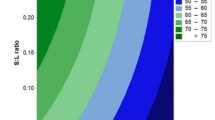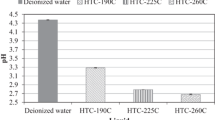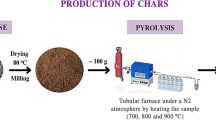Abstract
Wet waste feedstocks present an attractive opportunity for biomass conversion to fuels by hydrothermal processing. In this study, grape pomace slurries from two varieties, Montepulciano and cabernet sauvignon, have been converted into a biocrude by hydrothermal liquefaction (HTL) in a bench-scale, continuous-flow reactor system. Carbon conversion to gravity-separable biocrude product up to 56% was accomplished at relatively low temperature (350 °C) in a pressurized (sub-critical liquid water) environment (20 MPa) when using grape pomace feedstock slurry with a 16.8 wt% concentration of dry solids processed at a liquid hourly space velocity of 2.1 h−1. Direct biocrude recovery was achieved without the use of a solvent and biomass trace mineral components were removed by precipitation and filtration so that they did not cause processing difficulties. In addition, catalytic hydrothermal gasification (CHG) was effectively applied for HTL byproduct water cleanup using a Ru on C catalyst in a fixed bed producing a gas composed of methane and carbon dioxide from water-soluble organics. Conversion of 99.8% of the chemical oxygen demand (COD) left in the aqueous phase was demonstrated. As a result, high conversion of grape pomace to liquid and gas fuel products was found with residual organic contamination in byproduct water reduced to <150 mg/kg COD.



Similar content being viewed by others
References
Déniel M, Haarlemmer G, Roubaud A, Weiss-Hortala E, Fages J (2016) Energy valorisation of food processing residues and model compounds by hydrothermal liquefaction. Renew Sust Energ Rev 54:1632–1652. doi:10.1016/j.rser.2015.10.017
Karpe AV, Beale DJ, Harding IH, Palombo EA (2014) Optimization of degradation of winery-derived biomass waste by Ascomycetes. J Chem Technol Biot 90(10):1793–1801. doi:10.1002/jctb.4486
Elliott DC (2011) Hydrothermal processing. In: Brown RC (ed) Thermochemical processing of biomass: conversion into fuels, chemicals and power. John Wiley & Sons, Ltd., Chichester, pp 200–231
Vardon DR, Sharma BK, Scott J, Yu G, Wang Z, Schideman L, Zhang Y, Strathman T (2011) Chemical properties of biocrude oil from the hydrothermal liquefaction of Spirulina algae, swine manure, and digested anaerobic sludge. Bioresour Technol 102:8295–8303. doi:10.1016/j.biortech.2011.06.041
Marrone, P. (2016) Genifuel Hydrothermal Processing Bench-Scale Technology Evaluation Project. Water Environment & Reuse Foundation. https://www.werf.org/i/a/ka/Search/ResearchProfile.aspx?ReportId=LIFT6T14, Accessed 14 Sept 2016.
Barreiro DL, Prins W, Ronasse F, Brilman W (2013) Hydrothermal liquefaction (HTL) of microalgae for biofuel production: state of the art review and future prospects. Biomass Bioenergy 53:113–127. doi:10.1016/j.biombioe.2012.12.029
Subagyono DJN, Marshall M, Jackson WR, Chaffee AL (2015) Pressurized thermal and hydrothermal decomposition of algae, wood chip residue, and grape marc: a comparative study. Biomass Bioenergy 76:141–157. doi:10.1016/j.biombioe.2014.08.020
Subagyono DJN, Marshall M, Jackson WR, Chaffee AL (2015) Improvement in liquid fuel product quality from reactions of grape marc with CO/H2O. Fuel 159:234–240. doi:10.1016/j.fuel.2015.06.042
Valdez PJ, Dickinson JG, Savage PE (2011) Characterization of product fractions from hydrothermal liquefaction of Nannochloropsis sp. and the influence of solvents. Energ Fuel 25(7):3235–3243
Barreiro DL, Riede S, Hornung U, Kruse A, Prins W (2015) Hydrothermal liquefaction of microalgae: effect on the product yields of the addition of an organic solvent to separate the aqueous phase and the biocrude oil. Algal Res 12:206–212. doi:10.1016/j.algal.2015.08.025
Biller P, Sharma BK, Kunwar B, Ross AB (2015) Hydroprocessing of bio-crude from continuous hydrothermal liquefaction of microalgae. Fuel 159:197–205. doi:10.1016/j.fuel.2015.06.077
Barreiro DL, Gomez BR, Hornung U, Kruse A, Prins W (2015) Hydrothermal liquefaction of microalgae in a continuous stirred-tank reactor. Energ Fuel 29:6422–6432. doi:10.1021/acs.energyfuels.5b02099
Eager RL, Mathews JF (1981) Studies on the products resulting from the conversion of aspen poplar to an oil. Can J Chem 59:2191–2198
Elliott DC (2008) Catalytic hydrothermal gasification of biomass. Biofuels. Bioprod Bioref 2:254–265. doi:10.1002/bbb.74
Osada M, Hiyoshi N, Sato O, Arai K, Shirai M (2007) Effect of sulfur on catalytic gasification of lignin in supercritical water. Energ Fuel 21:1400–1405
Jazrawi C, Biller P, He Y, Montoya A, Ross AB, Maschmeyer T, Haynes BS (2015) Two-stage hydrothermal liquefaction of a high-protein microalga. Algal Res 8:15–22
Elliott DC, Hart TR, Neuenschwander GG, Rotness LJ, Olarte MV, Zacher AH (2012) Chemical processing in high-pressure aqueous environments. 9. Process development for catalytic gasification of algae feedstocks. Ind Eng Chem Res 51:10768–10777. doi:10.1021/ie300933w
Channiwala SA, Parikh PP (2002) A unified correlation for estimating HHV of solid, liquid and gaseous fuels. Fuel 81:1051–1063
Pedersen TH, Grigoras IF, Hoffmann J, Toor SS, Daraban IM, Jensen CU, Iversen SB, Madsen RB, Glasius M, Arturi KR, Nielsen RP, Søgaard EG, Rosendahl LA (2016) Continuous hydrothermal co-liquefaction of aspen wood and glycerol with water phase recirculation. Appl Energ 162:1034–1041. doi:10.1016/j.apenergy.2015.10.165
Elliott DC, Biller P, Ross AB, Schmidt AJ, Jones SB (2015) Hydrothermal liquefaction of biomass: developments from batch to continuous process. Bioresour Technol 178:147–156. doi:10.1016/j.biortech.2014.09.132
Jarvis JM, Billing JM, Hallen RT, Schmidt AJ, Schaub TM (2017) Hydrothermal liquefaction biocrude compositions compared to petroleum crude and shale oil. Energ Fuel 31:2896–2906. doi:10.1021/acs.energyfuels.6b03022
Panisko E, Wietsma T, Lemmon T, Albrecht K, Howe D (2015) Characterization of the aqueous fractions from hydrotreatment and hydrothermal liquefaction of lignocellulosic feedstocks. Biomass Bioenergy 74:162–171. doi:10.1016/j.biombioe.2015.01.011
Elliott DC, Hart TR, Schmidt AJ, Neuenschwander GG, Rotness LJ, Olarte MV, Zacher AH, Albrecht KO, Hallen RT, Holladay JE (2013) Process development for hydrothermal liquefaction of algae feedstocks in a continuous-flow reactor. Algal Res 2:445–454. doi:10.1016/j.algal.2013.08.005
Elliott DC, Neuenschwander GG, Hart TR, Butner RS, Zacher AH, Engelhard MH, Young JS, McCready DE (2004) Chemical processing in high-pressure aqueous environments: 7. Process development of catalytic gasification of wet biomass feedstocks. Ind Eng Chem Res 43(9):1999–2004. doi:10.1021/ie034303o
Carrier M, Loppinet-Serani A, Absalon C, Marias F, Aymonier C, Mench M (2011) Conversion of fern (Pteris vittata L.) biomass from a phytoremediation trial in sub- and supercritical water conditions. Biomass Bioenergy 35:872–883. doi:10.1016/j.biombioe.2010.11.007
Elliott DC, Hart TR, Neuenschwander GG (2006) Chemical processing in high-pressure aqueous environments. 8. Improved catalysts for hydrothermal gasification. Ind Eng Chem Res 45(11):3776–3781. doi:10.1021/ie060031o
Acknowledgements
The authors acknowledge the support for this research provided by the US Department of Energy through its Bioenergy Technologies Office (BETO). Pacific Northwest National Laboratory is operated for the US Department of Energy by Battelle under Contract DE-AC06-76RL01830. Thanks are extended to Larry Oats of Sleeping Dog Winery in Benton City, Washington and Juan Munoz-Oca, Senior Director of Winemaking, Paterson Group of Wineries, Ste. Michelle Wine Estates, for making the grape pomace feedstocks available for these experiments.
Author information
Authors and Affiliations
Corresponding author
Rights and permissions
About this article
Cite this article
Elliott, D.C., Schmidt, A.J., Hart, T.R. et al. Conversion of a wet waste feedstock to biocrude by hydrothermal processing in a continuous-flow reactor: grape pomace. Biomass Conv. Bioref. 7, 455–465 (2017). https://doi.org/10.1007/s13399-017-0264-8
Received:
Revised:
Accepted:
Published:
Issue Date:
DOI: https://doi.org/10.1007/s13399-017-0264-8




